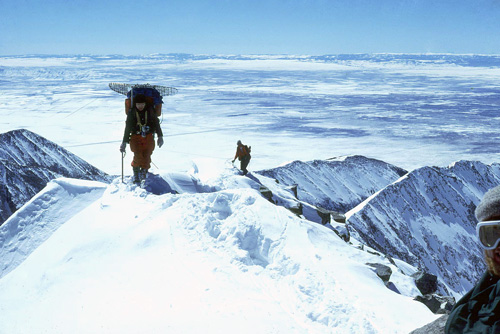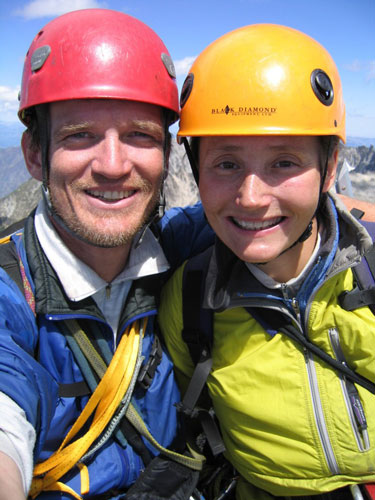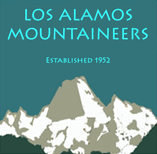|
18. Some of the Years' Most
Memorable Programs
LAM History Index |
Go
to Previous Topic |
Go to Next Topic The Mountaineer's
monthly meetings (currently the third Wednesday of every month, at
Fuller Lodge, 7:30 PM) feature a slide show program on an outdoor
activity by club members or invited speakers. The speakers may show
photos taken on club trips or on their own personal trips or
expeditions. These programs provide a great way for the members to share
in exciting adventures that others have taken and to get a better sense
of the many wonderful possibilities that exist for exploring the
outdoors. Often they provide the audience members with new ideas for
trips that they can do in the future.
The Mountaineers have also occasionally invited well-known climbers,
mountaineers, archeologists, and other outdoorsmen to present programs
to the club. Over the years these have included famous climbers such as
Pat Ament, Fred Beckey, Todd Bibler, Jim Donini, George Hurley, Aron
Ralston, Gaston Rebuffat, John Sherman, and others. Gaston Rebuffat, a
well-known French climber, gave a presentation to the club in the late
1950's, and had dinner with Tom Newton, the club's founder, and his
family at their house. Gary and Lynn Clark have given us excellent
presentations on many of the climbs in their list of "North American
Classics".
Perhaps the most interesting and most gripping programs are those that
were presented by club members who are also well-known mountain climbers
in the US climbing community and who have taken part in expeditions to
other parts of the world. These include especially memorable programs by
George Bell, Eiichi Fukushima, and Don and Alice Liska.
George Bell gave the Mountaineers several excellent presentations on his
climbs and treks in the Himalayas and in Peru. George and Ginny Bell
loved Nepal, Bhutan, Pakistan, and northern India. They did 12 treks
there and gave presentations on some of these trips. George was justly
famous for his participation in the 1953 American expedition to K-2, a
climb that was immortalized in the book "K2, the Savage Mountain," by
Charles Houston and Robert Bates. Every 5 or 10 years, he would offer to
give his account of that expedition to the Mountaineers, and those of us
who were lucky enough to attend one of those programs will always
remember it.
During that climb of K-2, at 25,000' on the mountain, they endured a
horrific storm for a week. One member of the party became ill, and the
group began a long and dangerous descent. Someone slipped, and the whole
party began to fall towards certain death. One climber, Pete Schoenig,
managed to catch the other climbers with "The Belay," perhaps the most
famous save in all of mountaineering history. "This was a pivotal event
in the lives of the surviving team members, who became as close as
brothers. George was carried out from base camp and eventually lost two
toes to frostbite. Despite this, his enthusiasm for climbing was
undiminished. He went on several more Himalayan expeditions, culminating
in the first ascent of Masherbrum in 1960 (the 25th highest peak in the
world)."
Without that successful belay, the Mountaineers would never have had the
chance to meet George Bell or hear the gripping story of the K-2
expedition. A November 2, 2006 Newsweek on-line article on MSNBC by
Karen Molenaar Terrell documented the August 2006 reunion meeting of 28
descendants of the "Children of the Belay." These were the children or
grandchildren who would never have been born except for that famous
belay. George Bell's wife, son, daughter, and grandchildren attended the
meeting, which was held in the town of Leavenworth, Washington. Ginny
Bell remembers that many of these descendants became very close, like
the original climbers.
In 2002 or 2003, Ginny Bell also did a Mountaineers' program on K-2 with
the help of Don and Alice Liska. She showed the BBC documentary that was
prepared on the history of climbing K-2, which began with the first
Italian trip led by the Duke of Abruzzi. The documentary also described
the American climb in 1953 and the successful Italian climb the
following year. She also showed part of the detailed interview of George
Bell that the BBC filmed in March 2000, two months before his death.
Eiichi Fukishima, whose climbing career began in Seattle, was a member
of the Los Alamos Mountaineers from 1967 until the 1990's. While living
in Los Alamos, Eiichi led a Mountaineers' trip to Mts. Shuksan and Baker
(in 1973) and several winter climbs to the Spanish Peaks, Ellingwood
Peak, and Tijeras Peak in Colorado. He has given several presentations
to the Mountaineers on his expeditions to Greenland and Antarctica.

Fig.
1. Eiichi Fukushima and Karl Mueller on the West Ridge of
Ellingwood Peak (March 1979, Bob Cowan photo).
In 1966, Eiichi was a
member of the first team to ascend Mount Vinson, the highest mountain in
Antarctica and the world's "Seventh Summit." In addition to Vinson, the
1966 team made the first ascents of Tyree, Shinn, Gardner, Ostenso and
Long Gables. It was one of the most successful mountaineering
expeditions ever to leave America's shore. This past year, Eiichi gave a
program on the 40th anniversary attempt on Mt. Vinson, which included
Eiichi and several other members of the 1966 team. While they were not
quite as successful, the 2006 team (now in their 60's and 70's rather
than 20's and 30's) came within 100 vertical feet of the top.
Eiichi Fukushima, Larry Campbell, and Don Liska made a trip to Greenland
in 1971 and gave the Mountaineers a great slide show (organized by Dan
Elliott). This is a wild region which no other club members have ever
seen. The expedition's goal was to do a first ascent of Mt. Inar
Mickelson, which was unclimbed at that time. If they reached the top
successfully, they planned to use a theodolite to compare the height of
that peak to that of the nearby Mt. Gunsbyornfeld, which was claimed,
but not with certainty, to be the highest peak in Greenland. Larry
Campbell recalls that they tried hard to interest George Bell in the
trip, but he said there were too many uncertainties. As it turned out,
there was too much ice in the fiord that had to be used to approach the
peak, so they could not be dropped off close enough to have a chance of
climbing it. They also had delays getting out because the fiord was
starting to freeze up, and they had to rely on the help of the native
Eskimos to recover their gear. Nevertheless, this expedition was a great
adventure for them, and a trip that helped define the breadth of the
Mountaineers' interests.
Over the years, Don and Alice Liska have regaled the club with many
adventuresome and well-told stories of their climbs in Alaska,
Greenland, Peru, Switzerland, and Asia, including their exciting climbs
of Mt. Robson, Mt. Waddington, and Mt. St. Elias in Canada (program
given in 1979). Their climbs on Shiprock and their involvement in its
history, as described to the club in a fascinating recent program, are
summarized in an earlier section of this history. Their program on the
expedition to Afghanistan in 1969 is called out here because of its
unique nature.
Don and Alice visited
Afghanistan in the summer of 1969 as part of an expedition led by a
well-known German climber, Richard Hechtel. The party climbed Noshaq
(7492 meters or roughly 24,600 feet), the highest peak in Afghanistan's
Hindukush range. The peak is located about 200 miles from K-2 in the
long narrow Wakhan Corridor of northeast Afghanistan, on the border with
Pakistan. They were the first Americans to enter the Wakhan Corridor,
making it perhaps the most unusual location ever visited by members of
the Los Alamos Mountaineers. It is a very beautiful area, but is
nowadays completely inaccessible to anyone from the West. From Kabul,
the party traveled in an old rented schoolbus, complete with driver, two
mechanics, and a large supply of spare parts. The bus was both home and
livelihood for the 3 Afghans, and they worked hard to get it across
streams and other obstacles. At one point they completely rebuilt the
transmission! The party stayed overnight in teahouses where they slept
on the floor and ate local bread and rice.
The Afghans were not accustomed to seeing a woman wearing outdoor
clothes, and Alice was often stared at or spit at. One small strong wiry
Afghan was very chivalrous and carried her across a raging stream on his
back. But often Alice was very uncomfortable. This was a time when,
according to James Michener's book "Caravans," women were still being
stoned to death for being improperly dressed. She had not planned on
doing the climb of Noshaq, but it was not feasible for her to stay in
base camp while the other climbers were on the mountain, or to travel
around the countryside alone. So she joined the 6 male climbers for the
two-week climb.
Alice says that "The men encouraged me to do the climb with them. The
porters did not come up on the mountain past base camp, so we all got in
better shape ferrying loads to higher camps. We did not bring any oxygen
bottles, even though oxygen was commonly used by other climbers at those
altitudes. Near the top, I could only take 3 steps between rests,
whereas Don could take 10. There was a small knoll 200 feet from the
top, and I sat down and didn't want to go on. But Don came back down and
then went back up to the summit with me. I was very pleased, but
exhausted. I have never been so tired in my life, either before or
after."

Fig.
2. Alice Liska on the summit of Noshaq
(Don Liska photo, August 1969).
In his book "The
Merry-Go-Round of My Life," trip leader Richard Hechtel recalled that
"We all met again a short distance below the summit. Alice had a little
smile on her face. She was now the highest woman on earth." Indeed, Don
says that "Alice's climb added glory to the trip. The fact that she
carried her own gear, climbed without porter support, and used no oxygen
made this a high standard achievement for a woman in 1969." For about 8
years, Alice held the world altitude record for a woman from the Western
World. She was invited to be on the radio program "Today's First Lady,"
and she also appeared on the television show "To Tell the Truth" as one
of three contestants claiming to be the woman with the altitude record.
Alice was required to answer all questions truthfully, but the two
imposters could lie. In the end, two of the panelists were fooled, but
Kitty Carlisle correctly picked her out as the real Alice Liska.
A recent memorable
program was given by Eric Ponslet and Lucie Parietti, who represent a
new generation of very active Mountaineers. They had taken the club's
climbing school in 1995, soon after graduating from Virginia Tech and
moving to Los Alamos. They were immediately hooked on rock climbing and
they soon added snow and ice climbing to their activities. "After many
years of intense 'weekend warrior' climbing life, we decided to take the
plunge." In January 2003 they bought an old Greyhound bus that had been
converted into a motor home, quit their engineering jobs in Los Alamos,
and headed for the open road. Over the next two years they drove to
Colorado, Wyoming, Montana, Canada, Nevada (Red Rocks), California
(Bishop area), Oregon, and Washington. They spent roughly 270 days rock
climbing, ice climbing, and mountain snow climbing before returning to
Los Alamos to (reluctantly) resume their former lives. Eric and Lucie
described their adventures to the club in a beautiful slide, video, and
music program in May 2007. Sadly, they also announced that they were
leaving again for another two year trip to Canada, Alaska, New Zealand,
Australia, Red Rocks (their favorite rock climbing area), the eastern
US, and Quebec (for more ice climbing, their favorite activity of all).
Details of their past trip, and ongoing information on their future
adventures, can be found at their great website,
http://www.ericandlucie.com.

Fig.
3. Eric and Lucie on one of their recent climbing adventures
(photo by Eric or Lucie).
(Please note that
information on recent and upcoming club programs is given
elsewhere on the
Mountaineer's website, and that many recent trip reports by club
members are also available on this website.)
LAM History Index |
Go
to Previous Topic |
Go to Next Topic
.
|



